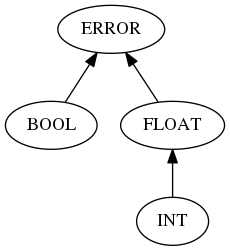Assignment 5
+125
For assignment 5, we will extend the calculator language and its type checker (described in the type checking notes) in the following ways.
We add Boolean values
trueandfalseto the language:expr : … | bool #BoolExpr ; bool : 'true' | 'false' ;We add a Boolean NOT operator (
!) at the same precedence as numeric negation:expr : op=('-'|'!') expr #NegExpr | ...We add relational operators that compare numbers and produce a Boolean value:
expr : … | left=expr op=('<'|'<='|'>'|'>=') right=expr #OpExpr | …We add equality (
=) and not-equals (<>) operators that can compare numbers or Booleans, and produce a Boolean:expr : … | left=expr op=('='|'<>') right=expr #OpExpr | …We add a conditional expression that takes three sub-expressions. If the first one evaluates to
true, it evaluates the second expression; otherwise it evaluates the third.expr : … | 'if' expr 'then' expr 'else' expr #IfExpr | …We now will support implicit coercion from values of type
INTto typeFLOAT, which means we no longer need thefloat()function to do that explicitly. We refer toINTandFLOATas numeric types. TheBOOLtype should not automatically convert toINTorFLOAT. It is not a numeric type.
Type hierarchy, useful for calculating the least upper bound of two types.
We support the following functions:
floor : (FLOAT) → INTsqrt : (FLOAT) → FLOATlog : (FLOAT, FLOAT) → FLOAT
where the
logfunction takes the input number followed by the base of the logarithm. So we would codelog(35,2)for \(\log_2(35) \approx 5.12928301694\) orlog(256,10)for \(\log_{10}(256) \approx 2.40823996531\).
The above grammatical changes have already been made in src/main/antlr/CalcLang.g4 in the assn5 project of the public repository. Your task is to update the type checker to implement the typing rules appropriately. Specifically:
Add a
BOOLentry to theTypeenumeration.Obviously, the values
trueandfalseshould have typeBOOL.\[\frac{}{\Gamma\vdash\texttt{true}:\texttt{BOOL}}\qquad \frac{}{\Gamma\vdash\texttt{false}:\texttt{BOOL}}\]
The numeric negation operator (unary
-) should be applied only to numeric types, not to Booleans. Conversely, the Boolean NOT operator (unary!) should be applied only to Booleans, not to numeric types. In each case, it does not change the type of the operand.\[\frac{\Gamma\vdash \texttt{e} : \texttt{INT}} {\Gamma\vdash \texttt{-e} : \texttt{INT}} \qquad \frac{\Gamma\vdash \texttt{e} : \texttt{FLOAT}} {\Gamma\vdash \texttt{-e} : \texttt{FLOAT}} \qquad \frac{\Gamma\vdash \texttt{e} : \texttt{BOOL}} {\Gamma\vdash \texttt{!e} : \texttt{BOOL}}\]
Note: the horizontal bar in this notation represents logical implication (also known as ‘if-then’). The left-most rule is read “if the environment \(\Gamma\) (gamma) entails that expression
ehas typeINT, then the same environment entails that the expression-ehas typeINT.”The five arithmetic operators (
^,*,/,+,-) work on any numeric operands, but not Booleans. The result type is the least upper bound (LUB) of the two operand types. So anINTplus anINTproduces anINT, but aFLOATplus anINTproduces aFLOAT. The typing rule shows the+operator, but the same rule applies to all five of them.\[\frac{\Gamma\vdash e_1 : \tau_1 \qquad \Gamma\vdash e_2 : \tau_2 \qquad \tau_1\in\{\texttt{INT},\texttt{FLOAT}\} \qquad \tau_2\in\{\texttt{INT},\texttt{FLOAT}\} } {\Gamma\vdash e_1\texttt{+}e_2 : \mathit{LUB}(\tau_1,\tau_2)} \]
Note: in this rule, we’re using the Greek letter \(\tau\) “tau” to represent one of our types, and we use subscripts on \(\tau\) and on \(e\) to distinguish between possibly-different types and expressions. The least upper bound \(\mathit{LUB}(\tau_1,\tau_2)\) is determined from the type hierarchy in the figure above.
The four relational operators (
<,<=,>,>=) work on any numeric operands, but not Booleans; however the result type is always Boolean. The typing rule shows the<operator, but the same rule applies to all four of them.\[\frac{\Gamma\vdash e_1 : \tau_1 \qquad \Gamma\vdash e_2 : \tau_2 \qquad \tau_1\in\{\texttt{INT},\texttt{FLOAT}\} \qquad \tau_2\in\{\texttt{INT},\texttt{FLOAT}\} } {\Gamma\vdash e_1\texttt{<}e_2 : \texttt{BOOL}} \]
Note: another way to specify \(\tau\in\{\texttt{INT},\texttt{FLOAT}\}\) is to write \(\mathit{LUB}(\tau,\texttt{FLOAT}) = \texttt{FLOAT}\).
The two equality operators (
=,<>) work on any compatible types, whether numeric or Boolean. The result type is always Boolean. The typing rule shows the=operator, but the same rule applies to both.\[\frac{\Gamma\vdash e_1:\tau_1 \qquad \Gamma\vdash e_2:\tau_2 \qquad \mathit{LUB}(\tau_1,\tau_2)\not=\texttt{ERROR}} {\Gamma\vdash e_1\texttt{=}e_2 : \texttt{BOOL}}\]
The first sub-expression in a conditional expression must have type
BOOL, and the types of the two branches must have a least upper bound that is notERROR.\[\frac{\Gamma\vdash e_1:\texttt{BOOL}\qquad \Gamma\vdash e_2:\tau_2\qquad \Gamma\vdash e_3:\tau_3\qquad \mathit{LUB}(\tau_2,\tau_3)\not=\texttt{ERROR}} {\Gamma\vdash \texttt{if }e_1\texttt{ then }e_2\texttt{ else }e_3 : \mathit{LUB}(\tau_2,\tau_3)} \]
Here are the typing rules for the functions, using the least upper bound calculation to allow implicit coercions.
\[\frac{\Gamma\vdash e:\tau \qquad \mathit{LUB}(\tau,\texttt{FLOAT})=\texttt{FLOAT}} {\Gamma\vdash\texttt{floor(}e\texttt{)} : \texttt{INT}}\]
\[\frac{\Gamma\vdash e:\tau \qquad \mathit{LUB}(\tau,\texttt{FLOAT})=\texttt{FLOAT}} {\Gamma\vdash\texttt{sqrt(}e\texttt{)} : \texttt{FLOAT}}\]
\[\frac{\Gamma\vdash e_1:\tau_1 \qquad \Gamma\vdash e_2:\tau_2 \qquad \mathit{LUB}(\tau_1,\mathit{LUB}(\tau_2,\texttt{FLOAT}))=\texttt{FLOAT}} {\Gamma\vdash\texttt{log(}e_1,e_2\texttt{)} : \texttt{FLOAT}}\]
The text files within the
tests/sub-directory represent test cases. You can run them using the main program classTestTypeChecker. All of the files should parse correctly. The files intests/badcontain type errors that your type checker should report. The files intests/goodcontain no type errors, so your type checker should accept them. (TheTypeCheckingVisitorincrements itserrorsfield each time theerror()method is called to report an error. So for all the files intests/goodwe expecterrors == 0; and for all the files intests/badwe expecterrors > 0.)